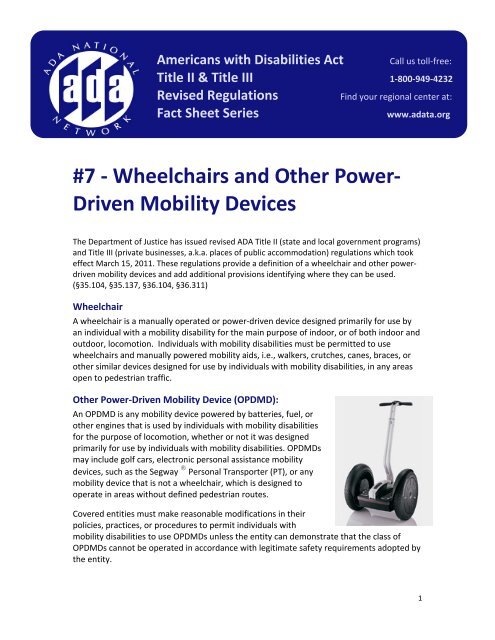Wheelchairs and Other Power- Driven Mobility Devices - Institute for ...
Wheelchairs and Other Power- Driven Mobility Devices - Institute for ...
Wheelchairs and Other Power- Driven Mobility Devices - Institute for ...
You also want an ePaper? Increase the reach of your titles
YUMPU automatically turns print PDFs into web optimized ePapers that Google loves.
Americans with Disabilities Act Call us toll‐free:Title II & Title III 1‐800‐949‐4232Revised RegulationsFind your regional center at:Fact Sheet Serieswww.adata.org#7 ‐ <strong>Wheelchairs</strong> <strong>and</strong> <strong>Other</strong> <strong>Power</strong>‐<strong>Driven</strong> <strong>Mobility</strong> <strong>Devices</strong>The Department of Justice has issued revised ADA Title II (state <strong>and</strong> local government programs)<strong>and</strong> Title III (private businesses, a.k.a. places of public accommodation) regulations which tookeffect March 15, 2011. These regulations provide a definition of a wheelchair <strong>and</strong> other powerdrivenmobility devices <strong>and</strong> add additional provisions identifying where they can be used.(§35.104, §35.137, §36.104, §36.311)WheelchairA wheelchair is a manually operated or power‐driven device designed primarily <strong>for</strong> use byan individual with a mobility disability <strong>for</strong> the main purpose of indoor, or of both indoor <strong>and</strong>outdoor, locomotion. Individuals with mobility disabilities must be permitted to usewheelchairs <strong>and</strong> manually powered mobility aids, i.e., walkers, crutches, canes, braces, orother similar devices designed <strong>for</strong> use by individuals with mobility disabilities, in any areasopen to pedestrian traffic.<strong>Other</strong> <strong>Power</strong>‐<strong>Driven</strong> <strong>Mobility</strong> Device (OPDMD):An OPDMD is any mobility device powered by batteries, fuel, orother engines that is used by individuals with mobility disabilities<strong>for</strong> the purpose of locomotion, whether or not it was designedprimarily <strong>for</strong> use by individuals with mobility disabilities. OPDMDsmay include golf cars, electronic personal assistance mobilitydevices, such as the Segway ® Personal Transporter (PT), or anymobility device that is not a wheelchair, which is designed tooperate in areas without defined pedestrian routes.Covered entities must make reasonable modifications in theirpolicies, practices, or procedures to permit individuals withmobility disabilities to use OPDMDs unless the entity can demonstrate that the class ofOPDMDs cannot be operated in accordance with legitimate safety requirements adopted bythe entity.1
Covered entities must assess the following factors to determine whether a particularOPDMD can be allowed in a specific facility as a reasonable modification:• The type, size, weight, dimensions, <strong>and</strong> speed of the device.• The facility’s volume of pedestrian traffic (which may vary at different times of theday, week, month, or year).• The facility’s design <strong>and</strong> operational characteristics (e.g., whether its service,program, or activity is conducted indoors, its square footage, the density <strong>and</strong>placement of stationary devices, <strong>and</strong> the availability of storage <strong>for</strong> the device, ifrequested by the user).• Whether legitimate safety requirements can be established to permit the safeoperation of the OPDMD in the specific facility.• Whether the use of the OPDMD creates a substantial risk of serious harm to theimmediate environment or natural or cultural resources, or poses a conflict withFederal l<strong>and</strong> management laws <strong>and</strong> regulations.InquiriesCovered entities shall not ask an individual using a wheelchair or OPDMD questions aboutthe nature <strong>and</strong> extent of the individual’s disability. Covered entities may ask a person usingan OPDMD to provide a credible assurance that the mobility device is required because ofthe person’s mobility disability. If the covered entity permits the use of a class of OPDMDsby individuals with mobility disabilities, they shall accept the following as credible assurance:• Presentation of a valid, State‐issued, disability parking placard or card, or otherState‐issued proof of disability. A valid disability placard or card is one that ispresented by the individual to whom it was issued <strong>and</strong> is otherwise in compliancewith the State of Issuance’s requirements.• A verbal statement, not contradicted by observable fact, that the OPDMD is beingused <strong>for</strong> a mobility disability.Call your Regional ADA Center at 1.800.949.4232 <strong>for</strong> more in<strong>for</strong>mation on<strong>Wheelchairs</strong> <strong>and</strong> OPDMDs <strong>and</strong> to get other Fact Sheets in our nine part series!2



